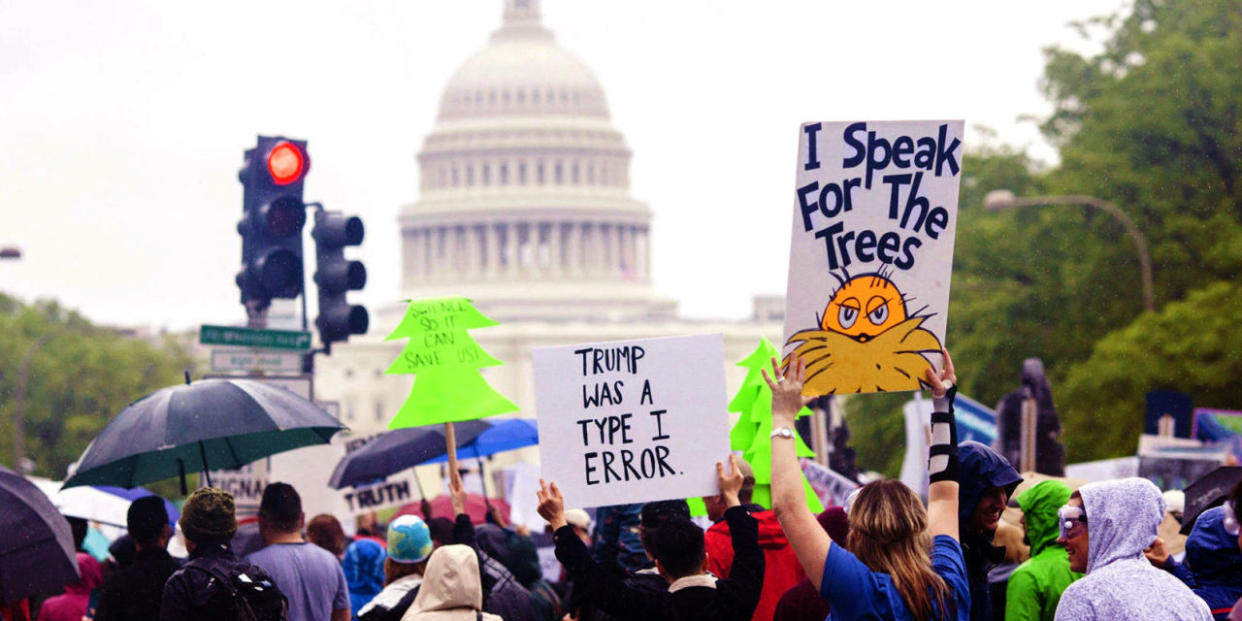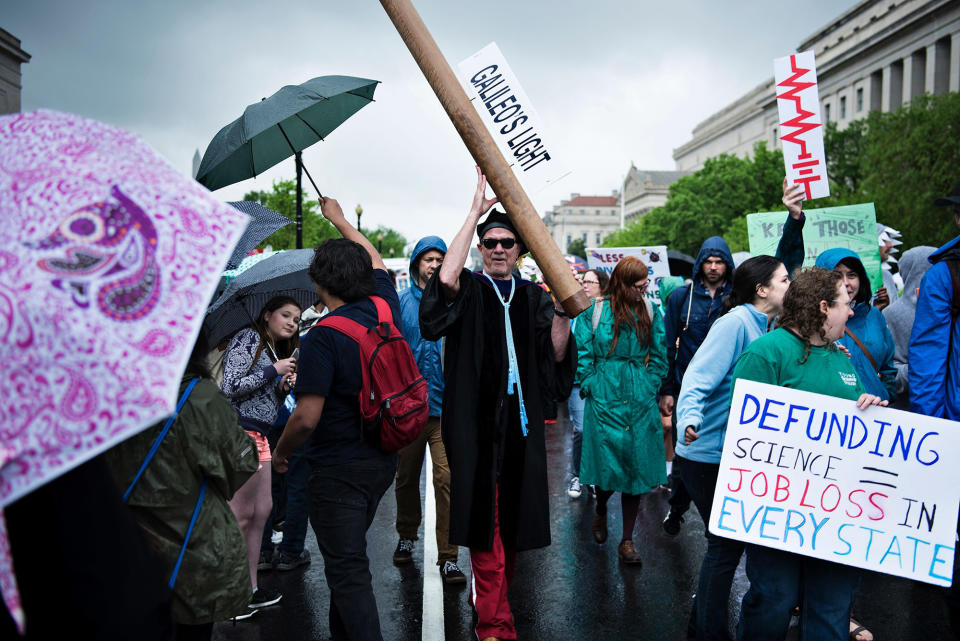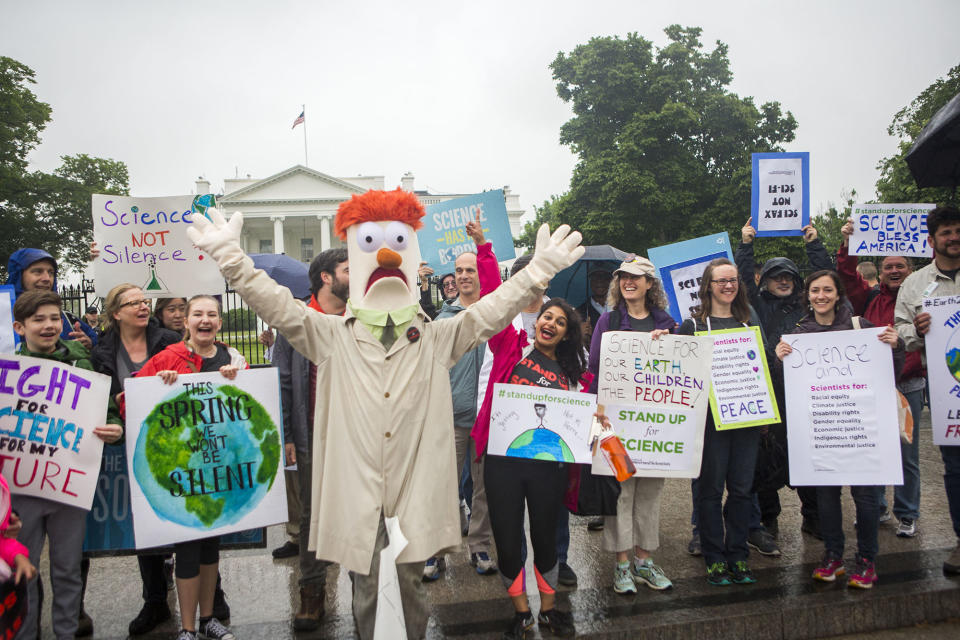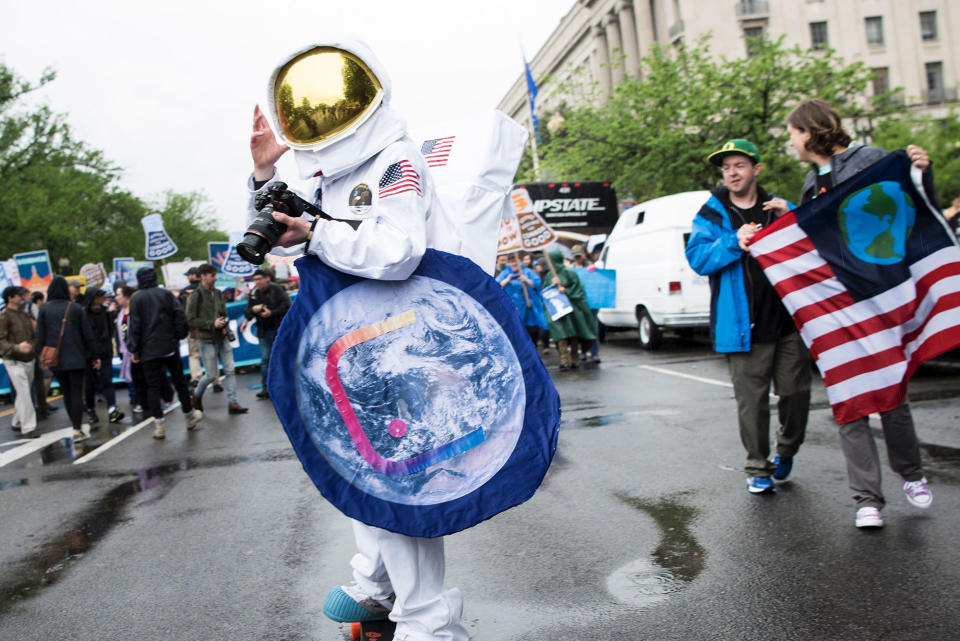Supporting Science is as American as the Constitution and the Founding Fathers

WASHINGTON-They named this town-Forgive me, This Town-after a man of science, a surveyor and an experimental farmer from down the cowpaths in Virginia. In 1783, while waiting to hear that the fighting part of the American Revolution was over, he took time to team up with another science aficionado, a not-altogether successful engineer named Thomas Paine, to investigate the phenomena caused by swamp gas in Virginia. Four years later, in a closed laboratory of politics in Philadelphia, he presided over the deliberations that produced a Constitution that, in the eighth section of its very first article, promised that the new government would,
"...To promote the Progress of Science and useful Arts..."
Talking through a thick mist thickening swiftly into a hard rain, and talking from a stage beneath the obelisk dedicated to that one famous polymath out of an age famous for producing them, Bill Nye took it upon himself to remind the people who had gathered on Saturday to March For Science, that they were descended in every important way from men of science.
The Framers of our Constitution, which has become a model for constitutions of governments everywhere, included Article I, Section 8... Its intent was to motivate innovators and drive the economy by means of just laws. They knew our economy would falter without them, without scientifically literate citizens, the U.S. cannot compete on the world stage.
(Speaking immediately before Nye, Manu Prakash, a Stanford neuroscientist, argued that scientific literacy was a basic human right because, in so many places, it literally is a matter of life and death.)
Yet, today, we have lawmakers, here and around the world, deliberately ignoring or actively suppressing science. Their inclination is misguided and it is in nobody's best interest.
This, of course, was the central paradox of Saturday's event, which coincided with the 47th celebration of Earth Day. It was the brainchild of a senator from Wisconsin named Gaylord Nelson, who had been on fire for what was then called "ecology" or "conservation" ever since he ran through the woods in and around Clear Lake, the small village in northern Wisconsin where he grew up.
As he came up through politics, Nelson was steeped in the Progressive heritage of his home state. In 1963, in his first year in the Senate after two terms as Wisconsin's governor, an ascension to which Nelson's environmental policies were critical, Nelson convinced President John F. Kennedy to embark on a series of speeches across the country concerning the environment, one of the most public demonstrations of White House commitment in that regard since the death of Teddy Roosevelt even though Kennedy was swamped on the tour with questions about a nuclear test-ban treaty that he'd recently concluded with the Soviet Union.

By 1970, Nelson was in his second term in the Senate and the news had become full of environmental catastrophe. In January of 1969, there was a massive oil spill off Santa Barbara in California and, almost exactly six months later, the Cuyahoga River in Cleveland famously caught on fire. On April 22, 1970, Nelson helped organize Earth Day, which was a massive outbreak of activism around the country. That kicked off what became known as the Environmental Decade, wherein was passed the Clean Air Act, the Clean Water Act, and other environmental regulations, all of them based on a sturdy bipartisan scientific consensus.
That was then. This is now. In 2017, the country needs a series of marches across the landscape to remind itself that scientific progress and American democracy are inextricably bound for their mutual survival. The current president* has leaked a budget that decimates the federal government's role in all manner of scientific research, from the fight against epidemic disease to the war on climate change. Which was why, walking through the drizzly day on the White House end of the National Mall, you saw epidemiologists sharing umbrellas with geologists, or a group of microbiologists huddling low under a spreading cherry tree alongside a knot of anesthesiologists. People walked around dressed as bees and as lobsters and as Beaker, the lab assistant from the Muppet Show. People walked around in overalls and in lab coats. They wore the now-classic pussy hats repurposed to resemble the configurations of the human brain and they wore stethoscopes around their necks.

"What do we want?" the signs said.
"Science!"
"When do we want it?"
"After peer review!"
(The musical interludes from the main stage were enlivened by the appearance of Thomas Dolby, who performed his hit, "She Blinded Me With Science," backed by John Batiste and Stay Human, which gave Dolby's vintage techno-pop tune a bit of New Orleans second-line juice.)
There was a great deal of infighting-"Some very ugly meetings," said one person familiar with them-about how specifically political the march should be. The older and more conventional scientists-most of them white males, for all that means in every public issue these days-tried to make the march and the events surrounding it as generic as possible.
The younger scientists, a more diverse groups in every way that a group can be, pushed back hard. The available evidence on Saturday was that their side had carried the day. Given the fact that, for example, Scott Pruitt, who took dictation from oil companies when he was Attorney General of Oklahoma, is now running the EPA, they could hardly have lost. More than a few signs reminded the current president* that, without science, he would be as bald as a billiard ball.
Generally, though, there was more than a little sadness on all sides that it ever had come to this, that a country born out of experimentation had lost its faith in its own true creation story, that a country founded by curious, courageous people would become so timid about trusting the risks and rewards of science.

Beka Economopoulos runs something called the Natural History Museum, a project that takes her around the country not only educating students on the natural world, but also taking expeditions to places in which environmental damage is severe. "We collaborate with scientists, local community organizations, and museums across the country to address pressing community concerns and global challenges," she said. "Science has never been apolitical. It's always been situated within a context. All science is dedicated to pursue truth, but there are decisions made on what kind of science gets funded and what doesn't, what kinds of questions get asked.
"The goal of science is not the popularization of knowledge. It's the pursuit of truth. Scientists look to obliterate existing knowledge by finding something beyond it. Copernicus, Galileo, Rachel Carson, these are scientists that disrupted the status quo but, we look back at them now, and we see that they advanced humanity and the world we live in."
When the speeches were done, all those people who'd hung in there through the rain walked up the wide boulevards past all the museums of the Smithsonian Institution, founded in the 1840's at the bequest of an Englishman named James Smithson. "I then bequeath the whole of my property... to the United States of America, to found at Washington, under the name of the Smithsonian Institution, an Establishment for the increase & diffusion of knowledge among men," Smithson's will read. As they walked past the buildings founded out of Smithson's generosity, you wondered in the mist and rain why it all seemed so much like archaeology now.
Respond to this post on the Esquire Politics Facebook page.
You Might Also Like

